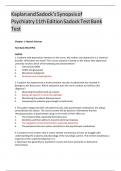Exam (elaborations)
Test Bank for Kaplan and Sadock's Synopsis of Psychiatry 11th Edition| 9781975145569| All Chapters 1-37|LATEST
Test Bank for Kaplan and Sadock's Synopsis of Psychiatry 11th Edition| 9781975145569| All Chapters 1-37|LATEST
[Show more]
Preview 4 out of 215 pages
Uploaded on
November 11, 2024
Number of pages
215
Written in
2024/2025
Type
Exam (elaborations)
Contains
Questions & answers
Institution
Kaplan And
Course
Kaplan And
$17.99
100% satisfaction guarantee
Immediately available after payment
Both online and in PDF
No strings attached
Kaplan and Sadock’s Synopsis of q q q q




